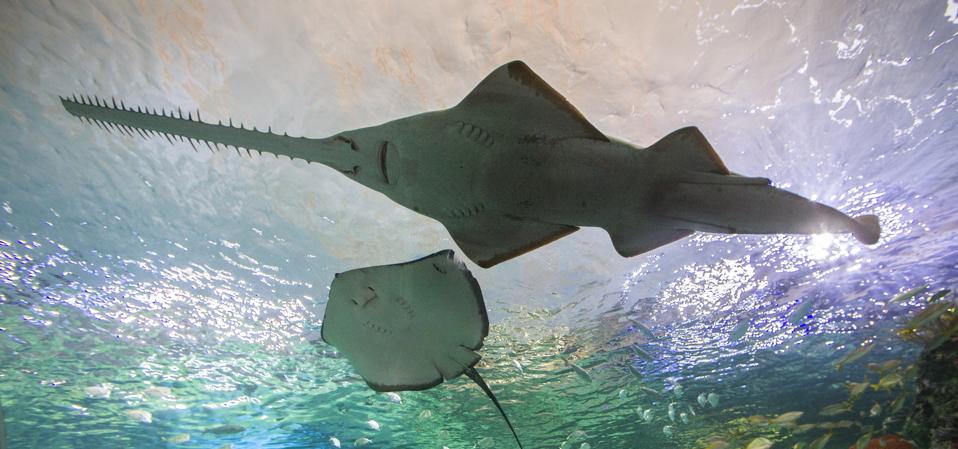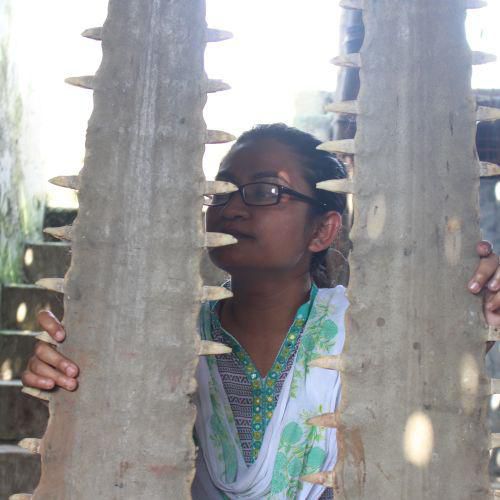
Bangladeshi researcher Alifa Bintha Haque with a Sawfish rostrum.
Aparna Riti Biswas
Bangladeshi biologist Alifa Haque is helping to study and preserve a mysterious and rare ray called the sawfish, but to do so, she must convince coastal communities that these irreplaceable animals are more valuable alive than dead.
Haque, who is a National Geographic Explorer and Edge of Existence fellow, says that before the 1990s, they were a regular catch in the Bay of Bengal off Bangladesh, but because of a traditional belief that that flesh can cure cancer, the sawfish is now a very rare sight.
“Each kilogram of meat can fetch 40 to 50 US dollars, which is a fortune considering that they could weigh up to 1000 kilograms and a monthly wage is only 30-40 US dollars in these communities, ” she says adding that a fisher who has problems at home would find it very tempting not to release the fish alive.
In addition to the flesh, the giant saw-like rostrum of the fish is often sold as a souvenir. Haque says that about 5 years ago, she visited a fisheries processing center in Bangladesh and got a big surprise.
“We were showing the head of the facility our photographs of rare sharks,” she says, “and all of a sudden, he went back and came out with a sawfish rostrum (the “saw” that gives these sharks their name) that was as tall as me!”
Haque says that being at the tip of of the Bay of Bengal, the coastal waters of Bangladesh are extremely bio-diverse but there is still a huge amount that isn’t know about how many species are there or the health of their populations.
“We documented more than 15 species for the first time in Bangladesh,” she says, “It wasn’t that they weren’t there before, it was that they hadn’t been looked for.”
For Haque, that was a huge clue that these critically endangered fish were still around.
“In just 15 months, we collected 14 landing of mostly largetooth sawfish,” she says, adding that this means there is probably still a breeding population in the shallow coastal waters of Bangladesh.
She now works with fishing communities to both educate them in the value of these creatures in their natural state, but also to work with those communities on conservation.
“One of the ideas that came out of the community was to get the most respected doctor in each community to debunk the ‘cancer cure’ myth,” adding that if sawfish go extinct, there’s nothing closely related to it replace it in the ecosystem.
Big City to Big Fish
Haque says that her passion for sawfish came relatively late in life compared to other conservationists, as she was brought up in the Bangladeshi capital of Dhaka, a city of over 20 million people.
“It’s a totally urban setting,” she says, “You wouldn’t see any trees, any nature and to be honest, I never thought I would become a biologist or a zoologist.”
But once she started her undergraduate degree in zoology, she was hooked.
“That’s where it all started, there’s a whole different world that we were not exposed to before, ” she said.
Haque would go on to study her Masters degree at Oxford University before returning to Bangladesh and being surprised at the number of sharks and rays being landed by fisherman on the Bay of Bengal.
Keep at it
Haque says that being a female marine biologist in Bangladesh has its challenges, including the cultural belief in some parts of the coast that is is bad luck having a woman on board a fishing vessel.
“But, I never felt insecure in these communities, they were very friendly and after two years they actually asked me to board their boat,” she says.
Haque’s message to women and girls interested in a life of science is to “keep at it.”
“Don’t let people say things that don’t help you, learn to tell between a criticism that can help you or one that won’t,” she says.
“There’s so much to do, so many unanswered questions and it is so much fun,” she says, adding that there’s a need for more women to get involved in field biology, especially in Bangladesh.
“There’s always a narrative difference between what a man and woman see in the world and we need to have a fuller vision of what is out there,” she said.
Haque says that being a National Geographic explorer has helped her to connect with researchers from all over the world.
“In 2019, we had this festival in Singapore where they invited lots of other explorers tackling with similar problems,” she said, “Those relationships are precious and we still discuss challenges among ourselves.”

A Sawfish in profile
Toronto Star via Getty Images
Another young woman in STEM making a difference for the conservation of sharks is Anna Oposa, co-founder of conservation NGO Save Philipines Seas, which aims to conserve and restore coastal and marine resources via environmental education and community-based projects.
She’s received 50,000 Euros to establish a shark sanctuary and to do additional stakeholder consultations, data collection, develop the management plan and an ordinance to establish the marine protected area network.




